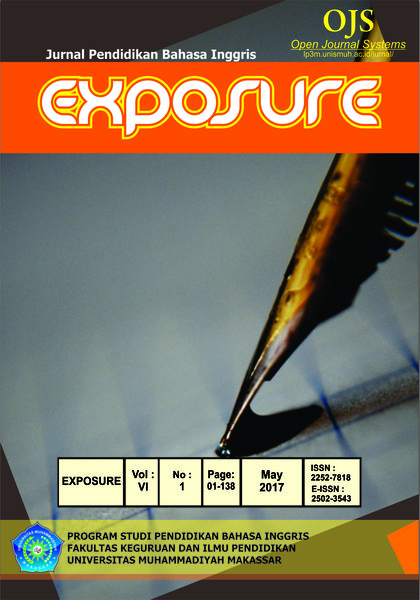STUDENT TO SELF-FEEDBACK IN IMPROVING STUDENTS’ SPEAKING ABILITY
DOI:
https://doi.org/10.26618/exposure.v6i1.931Keywords:
literal comprehension, action research, strategy, content, logical orderAbstract
This research is basically aimed to test the Student to the self-feedback method in improving their speaking ability. Furthermore, it is aimed to see the effectiveness of colleagues in helping other friends to learn. The method used in this research is the Quantitative method with the quasi-experimental setting in its test. The step of this research includes the field observation, pre-test, giving treatment by applying student to the self-feedback method, then post-test. One by one the student talks then another friend judge what the strengths and the weaknesses of his friend. The instruments used in this research are speaking test and questionnaire. The written assessment contained in the assessment aspect includes fluency, accuracy, and comprehensibility. The population in this research is all English education students of FKIP UIM. While the sample used is the second-semester students. The researchers divided the class into 2 groups. One group as the experimental class and the other as the control class.The results of the data analysis show that the probability is less than 0.05 or 0.000 <0.05. This means that H1 is acceptable and, of course, the statistical hypothesis H0 is rejected. Therefore, it can be concluded that the use of Student to self-feedback method improves their speaking ability.
Keywords: Students self-feedback, speaking ability
References
Akhter. 2007. Giving Feedback and Correcting Errors in ESL Classroom. BRAe University, Dhaka, Bangladesh
Anggraeni, dkk. Pemberian Umpan Balik (feedback) Terhadap Hasil Belajar dan Self-Efficacy Matematis Siswa Kelas VII SMP. Skripsi FKIP UNTAN. Pontianak
Arikunto, S. 2009. Dasar-Dasar Evaluasi pendidikan. Edisi Revisi. Jakarta : PT. Rineka Cipta
Brown, H. Douglas. 2000. Principles of Language Learning And Teaching. New York: Longman
Grauberg, Walter. 1997. The Elements of Foreign Language Teaching. Clevedon: Multilingual Matters, Ltd.
Hall, T. Simin. 2007. Improving Self-Efficacy in Problem Solving: Learning from Error and Feedback. Disertasi. Greensboro: The University of North California
Herman, Y. 2005. Pengaruh Umpan Balik Tes Formatif dan Gaya Kognitif terhadap Hasil Belajar Mata Kuliah Statistika (Studi Kasus pada Mahasiswa Jurusan PAI UNISMA Bekasi). Jakarta : Program Pasca Sarjana UNJ.
Race. Using Feedback to Help the Students to Learn. The Higher Education Academy.
Richards, Jack C, Lockhart, Charles.1997. Reflective Teaching in Second language Classrooms. United Kingdom: Cambridge University Press
Schunk, Dale H., Pintrici, Paul R., & Meece, Judith L. 2008. Motivation in Education: Theory, Research, and Applications Third Edition. New Jersey: Pearson Prentice Hall
Seruni dan Hikmah.2014. Pemberian Umpan Balik dalam Meningkatkan Hasil Belajar dan Minat Belajar Mahasiswa. Jurnal Formatif 4(3). Jakarta : Universitas Indraprasta PGRI.
Sholihin. 2013. Definition of Speaking Skill. http://rujukanskripsi.blogspot.co.id/2013/06/definition-of-speaking-skill.html. 26 April 2016.
Suhadi. 2008. Umpan Balik dalam Pembelajaran. http://www.suhadinet.wordpress.com. 10 februari 2013.
Thornbury, Scott. 2005. How to Teach Speaking. Longman.
Ulfa.2013. Metode Speaking Bahasa Inggris. http://hideyashu.blogspot.co.id/2013/01/makalah-metode-speaking-bahasa-inggris.html. 26 April 2016
Downloads
Published
Issue
Section
License
Authors who publish with this journal agree to the following terms:
In order to assure the highest standards for published articles, a peer review policy is applied. In pursue of the compliance with academic standards, all parties involved in the publishing process (the authors, the editors and the editorial board and the reviewers) agree to meet the responsibilities stated below in accordance to the Journal publication ethics and malpractice statement.
Duties of Authors:
- The author(s) warrant that the submitted article is an original work, which has not been previously published, and that they have obtained an agreement from any co-author(s) prior to the manuscript’s submission;
- The author(s) should not submit articles describing essentially the same research to more than one journal;
- The authors(s) make certain that the manuscript meets the terms of the Manuscript Submission Guideline regarding appropriate academic citation and that no copyright infringement occurs;
- The authors(s) should inform the editors about any conflict of interests and report any errors they subsequently, discover in their manuscript.
Duties of Editors and the Editorial Board:
- The editors, together with the editorial board, are responsible for deciding upon the publication or rejection of the submitted manuscripts based only on their originality, significance, and relevance to the domains of the journal;
- The editors evaluate the manuscripts compliance with academic criteria, the domains of the journal and the guidelines;
- The editors must at all times respect the confidentiality of any information pertaining to the submitted manuscripts;
- The editors assign the review of each manuscript to two reviewers chosen according to their domains of expertise. The editors must take into account any conflict of interest reported by the authors and the reviewers.
- The editors must ensure that the comments and recommendations of the reviewers are sent to the author(s) in due time and that the manuscripts are returned to the editors, who take the final decision to publish them or not.
Authors are permitted and encouraged to post online a pre-publication manuscript (but not the Publisher’s final formatted PDF version of the Work) in institutional repositories or on their Websites prior to and during the submission process, as it can lead to productive exchanges, as well as earlier and greater citation of published work (see The Effect of Open Access). Any such posting made before acceptance and publication of the Work shall be updated upon publication to include a reference to the Publisher-assigned DOI (Digital Object Identifier) and a link to the online abstract for the final published Work in the Journal.

